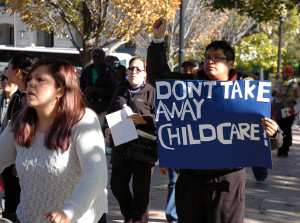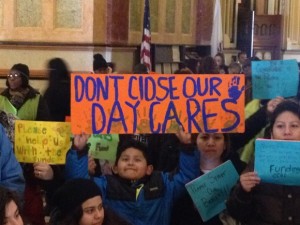As Gov. Rauner Deal Is Codified at JCAR Meeting, Major Threats to Child Care Remain

Child care providers, parents and working families rally at Lincoln Statue outside State Capitol in Springfield to call for passage of SB 570 to save CCAP program, Nov. 10th, 2015.
FOR IMMEDIATE RELEASE: Tuesday, Nov. 17, 2015
Contact: Graeme.Zielinski@seiuhcil.org
CHICAGO – SEIU Healthcare Illinois Vice President Brynn Seibert will be available Tuesday to the media to discuss the major threats to child care in Illinois that still exist, despite the 11th-Hour deal cut by Gov. Bruce Rauner that will be codified at a hearing of the Joint Committee on Administrative Rules. Seibert will be available before and after the 11 a.m. hearing on the 6th floor of the Bilandic Building, 160 N. LaSalle St.
Attacks on child care by Gov. Rauner continue in the courtroom and at the bargaining table, along with the dangers posed by his hastily-formulated and sloppy set of administrative rules.
Quick Facts About the Bruce Rauner Child Care Deal:
- If parent co-payments remain at the July 1st levels, the average co-pay increase is estimated to be $18.56/month. Since parents who were in the program before July 1st only pay the increase at their six-month redetermination, as we are in the 5th month under these rules ,most families are now paying the increased rates.
- A single mother working full time and earning minimum wage ($8.25/hour) with one child in care saw her co-payment increase by 19%.
- A parent working full time at $15/hour with two children saw their co-payment increase by 20%. They will end up spending an additional $432 a year on child care.
- There is no guarantee in the written rules that the Governor will restore eligibility to 185% of the Federal Poverty Level (FPL) once a budget is agreed to. The rules allow the lower eligibility levels to remain in effect if any appropriation is declared insufficient, which the Governor could claim even after a budget agreement is reached.
- The Governor already has alluded to responding to impending federal policy changes by cutting eligibility in the near future, and without SB570 to restrain him he will likely use his emergency rule power to alter the program again.
- Even with moving eligibility to 162% FPL, it is estimated that more than 10,000 children who would have been able to receive subsidies before July 1st remain ineligible even after the Governor’s deal.

Bruce Rauner and the Destruction of Child Care in Illinois:
1. What the Rauner cuts have done:
a. Kicked 70,000 kids and counting off child care.
b. Set eligibility so low that a parent working full-time at minimum wage makes too much to receive assistance.
c. Cost the state thousands of jobs as working parents lose child care arrangements-or drop out of the workforce.
d. Caused permanent damage to the community of child care providers, with more than 100 centers closing down and many providers leaving the field or being laid off.
2. What the Rauner deal does and when:
a. The Governor announced intent to amend his administration’s emergency rule to raise income eligibility to 162% of the federal poverty level.
b. Also announced he would form a task force to look at “the long-term stability of the program,” where no questions of “stability” in the successful program previously have been raised.
c. Offers no timeline for amending the emergency rule.
d. Provides no timeline for any deliverables, including the creation and population of the task force.
3. What the Rauner deal DOESN’T do:
a. Restore income eligibility – when the Rauner administration initiated the cuts, eligibility stood at 185% FPL and in recent years had been 200% FPL
b. Provide any co-pay relief for parents – “current co-pays will remain intact.”
c. Prevent the Governor from reversing course in the future – his ability to decimate child care through emergency rules would still hang over the program. In fact, the governor’s ability to do the same or worse would remains FULLY INTACT.
d. End the attacks against child care workers at the bargaining table, where the administration has sought to remove training and health care from state child care workers.
e. End the attacks against child care workers in the courtroom via Illinois Policy Institute, the avenging hand of his bank book.
